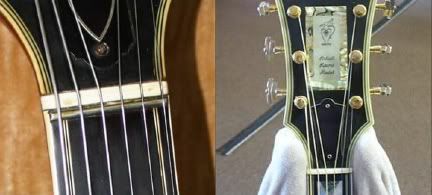capnjuan said:
What's with the zero fret?
On the left below, the guitar threaded here
Lark Street Georgie Boy and a plain vanilla
Artist Award ID'd in another thread. The GB has a zero fret, the AA doesn't.
Zero fret defined: chronic worry over one of these:
Although zero frets are seen on lesser quality instruments, they can also be found a higher quality instruments (some say to-may-toe, some say to-mah-toe).
The people at
Fret Not Guitar Repair say:
"On an instrument with a "zero fret", the traditional slotted nut still controls the strings spacing but the zero fret (which is actually fret wire) now controls the height of the strings above the frets. The strings will lay directly on the zero fret and string height will be adjusted by filing or replacing the zero fret instead of cutting the slots in the nut deeper. On instruments with zero frets the scale length is measured from the zero fret to the saddle as opposed to the nut to saddle.
Technically speaking, when you play a C chord, for example, some notes of the chord are fretted others are open. This means the fretted notes rest upon a fret when resonating and the open notes rest upon a bone/plastic nut. When fretting that chord on an instrument with a zero fret, all strings, even the open ones rest upon a fret. Now, take that and run with it. Theoretically you could argue that this sounds like a very good thing, but in the real world you'll find a variety of opinions."
The people at
Frets.com say:
"Likewise, the "zero fret" or "fret nut" is often associated with inexpensive instruments. It's not necessarily a cheaper way to make a guitar, and it is the way Selmer did it, so it's the way virtually all replicas are made, too. Detractors of the zero fret often cite the fact that it is a way to escape setting the height of the nut by avoiding the hand filing of each groove. In skilled hands, action setting at the nut takes only a few moments, so there really isn't all that much of a labor savings.


There's a lot of downward string pressure at the nut on any steel strung guitar with a slotted peghead. So, the metal bearing surface at the zero fret allows the string to slide over the nut more smoothly so the string doesn't "jump" or "ping" as it's tuned up. The bone nut only acts as a guide for spacing the strings and doesn't bear much load, so the string has far less tendency to settle into the bone and deform the bottom of the slots as it would in a traditional Martin design. As with so many other things, there's a down side, too. String windings are more likely to be damaged by the harder material of the zero fret than by a traditional bone nut."
Finally,
the Wikis say:
"The zero fret is primarily used to reduce production costs. The zero fret was commonly (but not exclusively) associated with cheaper instruments, since the cost of the labor involved in making a nut with slots carefully filed to the correct height is greater than the labor required to install a zero fret. Some manufacturers that frequently use(d) a zero fret are Gretsch, Kay, Selmer, Höfner, Mosrite, Anderson, and Vigier. Now very few manufacturers use this design and those who do list it as a feature.
It is claimed that, with a zero fret, the sound of an open string more closely approximates the sound of a fretted string as compared to the open string sound on a guitar with no zero fret. Countering this claim are musicians who feel that a bone or even synthetic nut will enhance the overall tone of the instrument regardless of the string being played open or fretted. Since tone is so subjective, the two claims are likely to continue in perpetuity."
So ... zero frets may or may not have an influence on tone but if a guitar is made with a zero fret, the location of the saddle would need to be taken into consideration. Without lubrication on either/both the nut and zero fret, it's a choice between gouging out the string slots and lowering the action v. wearing down strings windings and possibly shortening the useful life of the strings.



